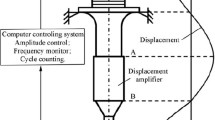Abstract
A combined cycle fatigue (CCF) testing system with ultrasonic frequency component was developed to evaluate the CCF properties of S350 steel welded joints in this study. The fatigue testing results indicated that the S-N curves of CCF did not have fatigue limit, which agreed with those of pure high frequency fatigue of welded joints. The S-N curves showed that the CCF strength of welded joints dropped greatly with the increasing interaction between high and low frequency fatigue loading. An approximation design method of CCF was presented using amplitude envelope as the stress range.
Similar content being viewed by others
References
Hobbacher A. Recommendations on Fatigue Design of Welded Joints and Components XIII-1539-96/XV-845-96[S]. 2002.
Mazur Z, Hernández-Rossette A, Porcayo-Calderón J. Fatigue investigation of the 69 MW gas turbine of a combined cycle unit[C]. In: ASME Turbo Expo 2010: Power for Land, Sea and Air. Glasgow, UK, 2010. 481–489.
Roder O, Peters J O, Thompson A W et al. Influence of simulated foreign object damage on the high-cycle fatigue properties of Ti-6Al-4V for gas turbine blades[C]. In: The 4th National Turbine Engine High Cycle Fatigue Conference. Monterey, USA, 1999.
Cowles B A. High cycle fatigue in aircraft gas turbines: An industry perspective[J]. International Journal of Fracture, 1996, 20(1): 82–83.
Hawkyard M, Powell B E, Hussey I et al. Fatigue crack growth under the conjoint action of major and minor stress cycles[J]. Fatigue and Fracture of Engineering Materials and Structures, 1996, 19(2–3): 217–227.
Namjoshi S A, Mall S. Fretting behavior of Ti-6Al-4V under combined high cycle and low cycle fatigue loading [J]. International Journal of Fatigue, 2001, 23(Suppl 1): S455–S461.
Dungey C, Bowen P. The effect of combined cycle fatigue upon the fatigue performance of Ti-6Al-4V fan blade material [J]. Journal of Materials Processing Technology, 2004, 153–154(1–3): 374–379.
Byrne J, Hall R F, Ding J et al. Fatigue crack growth from foreign object damage under combined low and high cycle loading (Part I): Experimental studies [J]. International Journal of Fatigue, 2007, 29(7): 1339–1349.
Mendia L, Estensoro F J, Mary C et al. Effect of combined cycle fatigue on Ti6242 fatigue strength[C]. In: The 11th International Conference on the Mechanical Behavior of Materials (ICM11). Como, Italy, 2011. 1809–1814.
Schweizer C, Seifert T, Nieweg B et al. Mechanisms and modeling of fatigue crack growth under combined low and high cycle fatigue loading[J]. International Journal of Fatigue, 2011, 33(2): 194–202.
Zhao Xiaohui, Wang Dongpo, Deng Caiyan et al. The fatigue behaviors of butt welds ground flush in the superlong life regime[J]. International Journal of Fatigue, 2012, 36(1): 1–8.
Author information
Authors and Affiliations
Corresponding author
Additional information
Supported by the National Natural Science Foundation of China (No. 51305295, No. 51375331 and No. 51105133).
Liu Yang, born in 1988, male, doctorate student.
Rights and permissions
About this article
Cite this article
Liu, Y., Wang, D., Deng, C. et al. Combined cycle fatigue testing with ultrasonic frequency component of S350 steel welded joint. Trans. Tianjin Univ. 20, 435–438 (2014). https://doi.org/10.1007/s12209-014-2199-5
Accepted:
Published:
Issue Date:
DOI: https://doi.org/10.1007/s12209-014-2199-5




